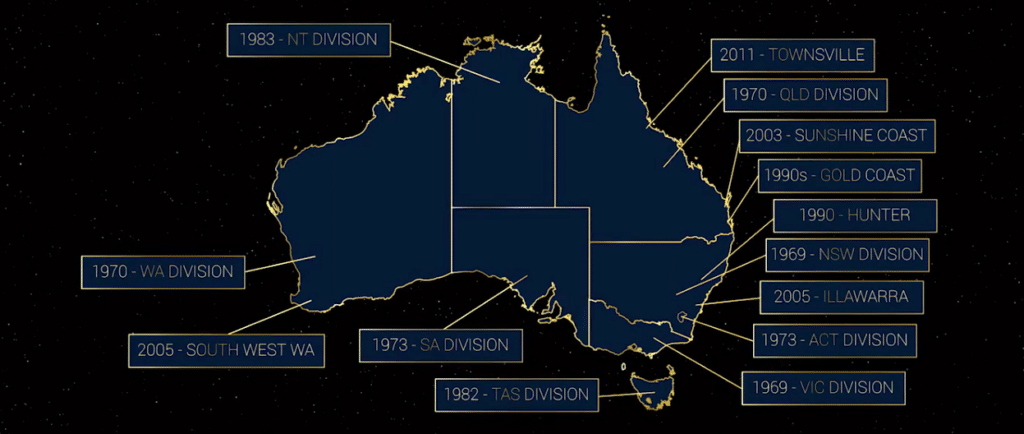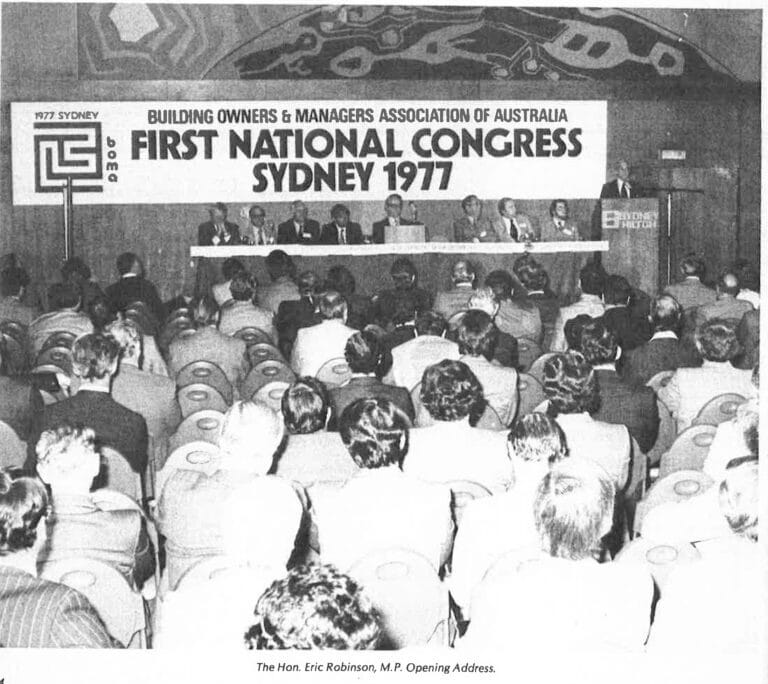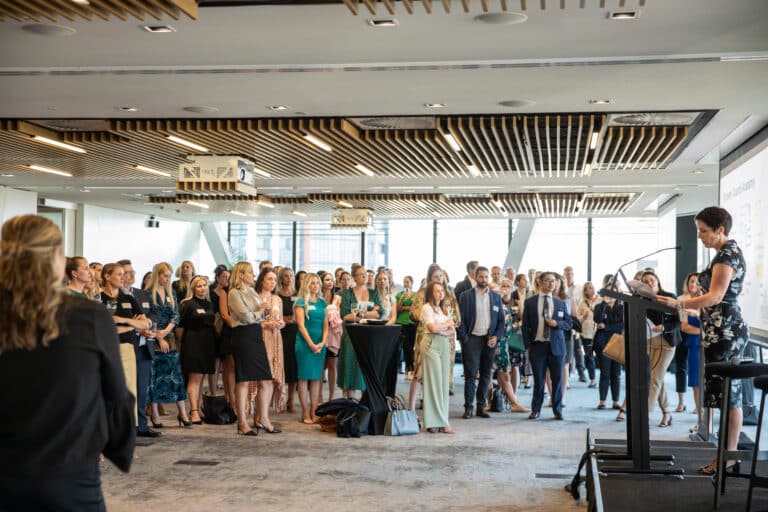The Property Council of Australia was founded in 1969 as the Building, Owners and Managers Association (BOMA), originally established as an educational and professional body that soon evolved to represent the interests of members on matters of public policy. The organisation officially became the Property Council of Australia in 1996, and today we represent Australia’s largest industry – shaping cities and creating communities.
Today, we are an organisation with truly national coverage, with a strong presence in every state and territory, as well as the Hunter, the Illawarra, the Gold Coast, Sunshine Coast and Townsville. And we represent all property sectors, from design and construction to asset investment, management and development.
The Property Council has played an integral role in growing the industry to the powerhouse that it is today. Find out more about our history and story below.
Origins
Our proud story starts in 1969, when a group of visionary property leaders gathered to create an association that could set standards, educate, advocate, and speak with one voice.
When Australia’s Building Owners and Managers Association opened its doors in 1969, our nation’s world-class property industry was in its infancy.
Building and rent controls, imposed during the Great Depression and only repealed after the Second World War, had taken their toll on people and the nation’s economy. Superannuation was confined to the public sector, and not one life or pension fund was empowered to invest in property. Building height limits were set by fire-ladder lengths. Few investors understood the concept of property as an asset class, and it was often relegated to the ‘miscellaneous’ column of the balance sheet, alongside the office furniture.
A surge in population growth and rapidly expanding manufacturing capabilities began to change the shape of Australia’s cities. Business districts and multi-storey headquarters were springing up in our capital cities as demand for office space grew. The post-war construction boom, led by visionary immigrants like Dick Dusseldorp, Frank Lowy, Ervin Graf and Luigi Grollo, fuelled innovation and investment in new technologies, construction methods and materials: lifts and air-conditioning, concrete and steel, curtain glass walls and pre-cast panelling. The sophistication of these buildings demanded professionals who could run them.
In 1968, the long-term head of AMP Property, Ray Powys, saw the potential for property as an investment asset class. He gathered together representatives from large property companies, national mutual societies and insurance firms, all with portfolios of large commercial buildings.
Looking to the United States, Ray and his colleagues found inspiration in a model that had created a profession of asset managers and advocated on the industry’s behalf. In 1969, Australia’s Building Owners and Managers Association was born.
While BOMA was originally established as an educational and professional body, it soon evolved to represent the interests of members on matters of public policy. Governments looked to BOMA for advice. A growing calendar of events connected the burgeoning industry, in turn supporting investment in advocacy, research and standard-setting.
Our organisation has steered the property industry’s course through both calm seas and rough waters. We weathered high inflation and unemployment in the 1970s, and the booms and busts of the 1980s. We were there to advocate for our industry as it was alternatively buoyed by reform and weighted down by recession through the 1990s. And we were there through the global financial crisis and beyond.
The organisation officially became the Property Council of Australia in 1996, and today we represent Australia’s largest industry – shaping cities and creating communities. We speak with a strong voice and we tell the industry’s inspiring stories to the world. And today, Australians have a deeper respect for property as a driver of growth, prosperity and opportunity – and of the central economic role this industry plays in the life of our nation.
Growth
From humble beginnings, BOMA quickly spread around Australia, expanding across property asset classes and growing to represent all dimensions of the real estate value chain.
The Building Owners and Managers Association’s original area of focus was CBD offices, but this soon expanded to other asset classes, including industrial, retail and other forms of commercial property.
BOMA opened its doors in 1969 with divisions in New South Wales and Victoria. Queensland and Western Australian branches were established the following year. By the end of 1973, the addition of the Australian Capital Territory and South Australia saw BOMA’s reach extend to six jurisdictions, with Tasmania following in 1982.
By the late 1990s, we were truly a national organisation and as our geographic footprint expanded, so did our cross-sectoral coverage. We established the Residential Development Council in 2001 to provide powerful advocacy on behalf of the sector that provides homes and drives so much of Australia’s economy. In the same year, we stepped up our focus on the vital investment and financing elements of the industry with the launch of our Capital Markets Division.
In 2012, we established the Retirement Living Council after incorporating the Retirement Village Association, growing to become the most powerful voice of the sector by harnessing the expertise of both not-for-profit and commercial village owners and developers. And in 2021 we formed the Student Accommodation Council to support the growth of this burgeoning industry that underpins Australia’s third largest export.
Today, we are an organisation with truly national coverage, with a strong presence in every state and territory, as well as the Hunter, the Illawarra, the Gold Coast, Sunshine Coast and Townsville. And we represent all property sectors, with an ambit and advocacy that spans asset investment, management and development.

Connection
The Property Council has brought the industry together to inspire, learn and forge new connections for five decades. Today 60,000-plus people attend our conferences and events right across the country.
Decades before Instagram or LinkedIn, we were connecting our industry with remarkable events. Our events program provides one of our great service areas for members – the Property Council runs an extraordinary 400-plus events a year, many of them with 1000+ attendees. We have always understood that every luncheon, seminar, conference or committee meeting is an opportunity for our industry to connect: enabling members to engage with market leaders, connect with clients, colleagues and competitors, and capitalise on the serendipity of sitting next to a new face and new opportunity.
Our marquee event has always been The Property Congress, held for the first time in 1977. It was a tough year of high inflation, low credit availability and rising unemployment. Speaking to the 250-strong audience, then president Peter Barrington emphasised our industry’s central role as one that reshapes our cities and makes them anew – a theme that would not be out of step with our program today.
From that very first gathering, The Property Congress has attracted our industry’s established and emerging stars, politicians and policymakers, as well as thinkers and troublemakers. Over the years, hundreds of industry leaders from Australia and overseas have shared their insights with thousands of attendees.
We established our Future Directions forum 25 years before other associations were looking to motivate millennials. We were driving the diversity agenda through a thought-provoking program when gender balance was only emerging on the corporate boardroom agenda. And we were hosting sustainability summits well ahead of the CSR curve.
We’ve always seen our events as forums to drive debate, test conventional thinking and spark new conversations. We’ve often chosen to feature the controversial and challenging – rock stars and reformers at The Property Congress, climate sceptics and nuclear energy champions at Green Cities, smart cities cynics at the Future Cities Summit and disruptive entrepreneurs at the National Retirement Living Summit.
We maintain the same mantra: provide access to the best ideas and let the people in our industry make up their own minds.
Today, the evolving story of our industry threads through the narrative of our events program. Whether we’re exploring blockchain, build-to-rent or big data, artificial intelligence or automation, e-commerce or energy efficiency, our events remain the best place in our industry to connect, collaborate and compete on a global stage.

A new name
By the mid-1990s the industry was brimming with new ambition and the desire to play its role on the national stage. And so the Property Council of Australia was born.
Recreating our association as the Property Council of Australia in 1996 positioned us as a uniquely powerful voice for Australia’s property industry.
The global recession in the 1990s, following the Black Monday stock market collapse, hit our industry hard. The Reserve Bank cash rate peaked at a punishing 17.5 per cent in January 1990, unemployment reached double digits and the national office vacancy rate passed 20 per cent.
But Australia’s property industry was rapidly professionalising. Traditional divisions between property sectors were blurring as companies expanded their portfolios, growing in strength and scale. After a slow start, Australian real estate investment trusts took off, and by the mid-1990s had grown to a capitalisation of $7 billion.
Relaunching as the Property Council of Australia enabled us to reinvigorate the organisation with a new language of prosperity and positivity – one that embraced our growing cities and communities. We began to explain the importance of cities as engine rooms of the economy and how all Australians had a stake in property through their superannuation.
The relaunch gave us a chance to rewrite our constitution, professionalise our governance and importantly, establish talented executive directors in each city with the skills needed to take our organisation forward. We were ready to expand the services we provided to our members.
Our investment in research and advocacy began delivering serious dividends and our political influence deepened. Under our new inclusive banner, we became the voice for a world-class property industry proudly playing its role on a global stage.
People
Property is all about people and the Property Council brings people together. Our committees and forums, education and resources provide people across the industry with new perspectives, new connections and new career opportunities.
We’ve played an instrumental role in professionalising the property industry over five decades. From the 1970s onwards, our event schedule established strong networks and built a base of home-grown talent, while our sustained work over several decades convinced universities to offer degrees in property economics.
We established our first practical and professional courses in shopping centre management and marketing way back in 1986. Since then our educational offerings, culminating in the launch of the Property Academy in 2011, have expanded to support all sectors of our industry with face-to-face and flexible learning. Today, we support the careers of more than 1,700 property professionals each year.
We look to the future by fostering aspiring leaders through our Future Directions network. We began applauding our young achievers with a generous scholarship in 1990, which has evolved into the prestigious Future Leader of the Year Award. Today Future Directions committees in each state and territory drive a dynamic program of events, research, thought leadership and networking to elevate our industry’s rising stars.
We are also committed to growing the industry’s diverse talent. The Property Council appointed our first female president, Carol Schwartz AO, in 1999 and since then we’ve challenged our members to step up and show leadership on gender diversity. In 2014, the Property Council commenced a proactive agenda to enhance diversity and expand the female talent pool. We’ve taken simple but strategic steps, like our 40:40:20 commitment which ensures balanced gender representation on committees, and the panel pledge, which promises that women in our industry will have an equal voice at our events.
The Property Champions of Change, 21 of our industry’s most powerful leaders, are listening, learning and leading with action to increase the number of women leaders across our industry and to grow the talent pool. Our 500 Women in Property program has acted as a career accelerator for many talented women at the early and mid-stages of their careers. And we’ve sparked a passion for property in the next generation of female leaders through Girls in Property.
People are our industry’s biggest asset: we know that the 1.4 million-strong workforce underpins the success of our industry and the future prosperity of our nation.

Our Advocacy Legacy
From the 1990s the Property Council began building its advocacy capacity at national, state and local levels.
With a federal government, eight state and territory parliaments and more than 500 local councils around the country, Australia’s political landscape is complex. Property is one of the few business sectors that must navigate all three levels of government.
Our formula for powerful advocacy was established early: deep member engagement, smart policy research, highly experienced employees, strong advocacy, and the ability to speak loudly and confidently about the issues that matter to our members. We’ve built our capability over many decades, employing the right people to enhance our advocacy professionalism, investing in the right research, and expanding our membership and the sectors we represent at the right time.
We advocate policies that create wealth and prosperity for entire communities – driven by sound research and solid facts, strong and coherent policy platforms and a significant investment by our industry. We take on the big issues that matter to our industry and our nation: planning, tax, infrastructure and regulation among them.
We’ve fought to remove red tape and repeal economically damaging taxes. We’ve championed smart, city-shaping policies long before Australia entered the metropolitan century. Years before Infrastructure Australia opened its doors, we were sharing smart research on where transport dollars should be spent. For a lonely decade we tirelessly championed Australian ‘city deals’ before their introduction.
Our first energy efficiency research report was released in 1977, guiding policy and action decades before the rest of the world caught up. Today, Australia’s property industry is the global leader in sustainable building, according to GRESB – an achievement that owes much to the research and advocacy agenda established nearly four decades ago.
Today, our advocacy success rests on our relationships with our industry. We are backed by our members and our $1.4 million research budget gives us powerful arsenal when we walk into the political fray.
We’ve played an instrumental role in establishing allied associations and collaborative forums – from the quietly revolutionary Green Building Council of Australia in 2002 to Livable Housing Australia in 2010. We’ve channelled our position of leadership to support the Property Industry Foundation’s mission and to encourage reconciliation through the CareerTrackers Indigenous internships program.
We’re not afraid of setting the agenda, and we speak loudly on issues that we believe will bring jobs, prosperity and strength to our cities and communities in a sustainable way.
The Property Council’s standing reflects the economic importance of our industry. We invest in research and data to help governments make good decisions for the future. We promote debate to improve public understanding of the issues at stake. And we champion an industry creating great places for all Australians.

